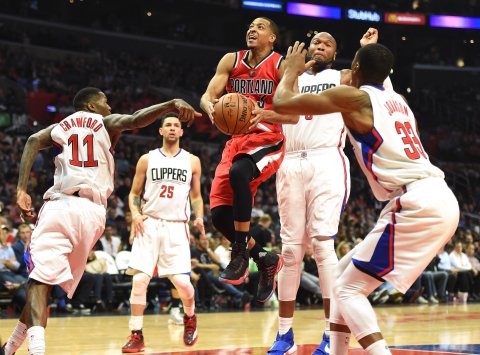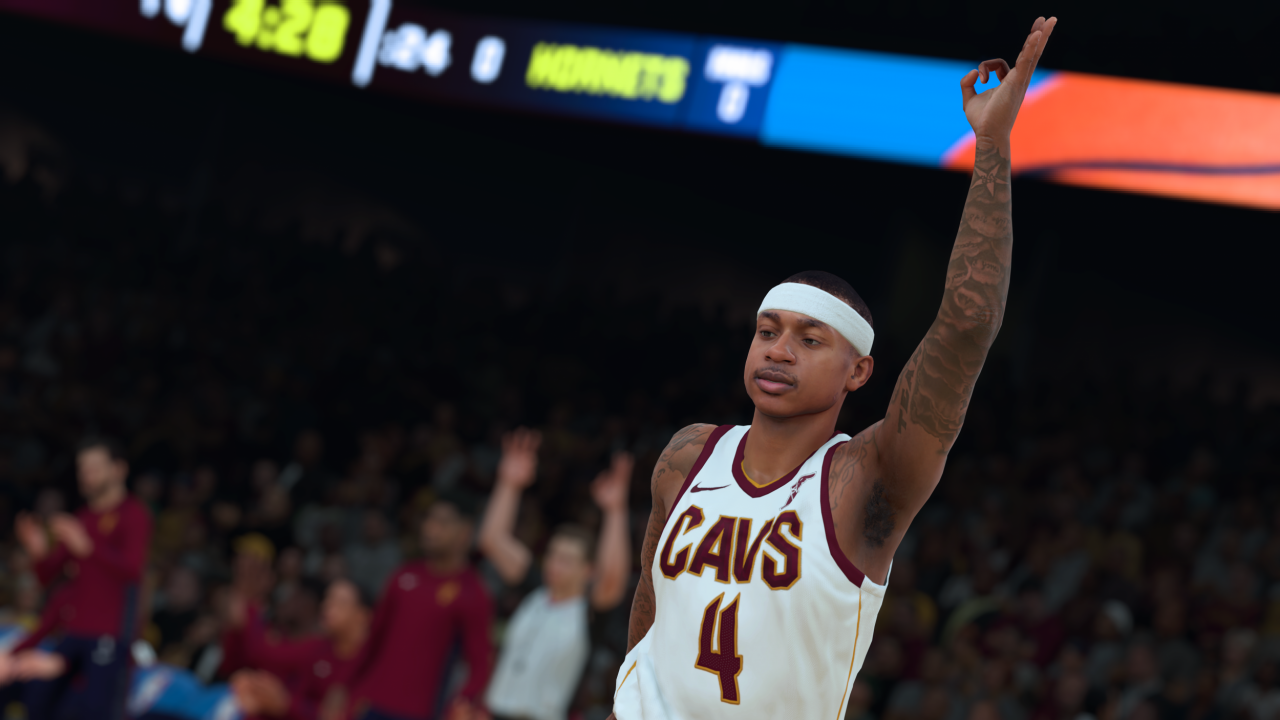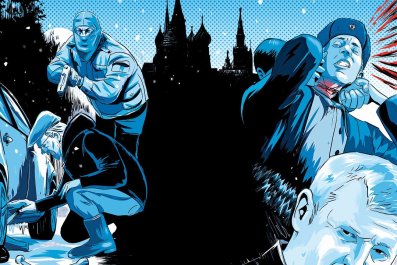The cramped room in Midtown Manhattan was packed wall-to-wall with YouTubers—a relentlessly cheery bunch—the lot of them excitedly live-streaming, likes and comments bobbing across their screens.
It was August, and the crowd was previewing the latest product from the NBA 2K video game series—NBA 2K18, which was released Friday to those who pre-ordered—and the event was crowded with elite gamers, social media stars, 2K staffers and, pocked about the room, honest-to-God, in-the-flesh NBA players. Security stood at the front door. Booze flowed from a bar in the back. TVs pinstriped the length of the room, cutting it into even rows. That was the main attraction, with the gamers lining up, jostling through the morass of people to get their turn on the joysticks (all of this, of course, beamed over the internet to 2K devotees).
In a room full of presumed NBA fans it was somewhat disorienting to see these NBA players—Brooklyn Nets guard D'Angelo Russell, or No. 3 overall pick Jayson Tatum, or Portland Trail Blazers' star C.J. McCollum—move through the place relatively un-bothered. Sure, they posed for a few photos—and yes, one particularly pushy guy inch-wormed his way into a conversation with all of them—but things were relatively calm, a break from the usual onslaught of middle-aged fans stampeding for autographs any time a pro athlete is near. The NBA stars were focused on doing NBA star things—posing for endorsement photos, chatting with press—while the gamers were focused on doing gamer things: hurriedly testing NBA 2K18's new features and describing it, beat by beat, into selfie sticks.
The scene hints at a larger symbiosis between the NBA itself and 2K, the pre-eminent basketball video game: It's all part of the same machine. The two have grown together, not necessarily in lockstep, but in conjunction. The NBA is more popular than ever and fans now count the days each year until the release of the game. Pro players stress about, and get angry over, their 2K rating. And with each year's iteration, 2K's gameplay edges ever-closer to mirroring the real NBA—that's to be expected, sports games are judged, in part, by their realism.
Gamers and video games, 2K chief among them, in some ways foretold years ago where the NBA is now. The recent innovations in the league—the explosion of 3-pointers, so-called tanking, the focus on "small ball"—which, combined, represent a sea-change in NBA play—nearly all of these tactics have been employed by 2K players for years.
Virtual has met reality.
Introducing the NEW #NBA2K18 cover ft. @KyrieIrving in a Boston Celtics uniform, to be released at a later date! https://t.co/9fcRLMh02k pic.twitter.com/vmdFQkv1vh
— NBA 2K (@NBA2K) September 7, 2017
A World Inside a Game
2K debuted in 1999 on the Sega Dreamcast, a long-dead antique of a system. It has since sold 70 million units, according to the company. It's widely considered the gold standard for modern sports video games, and has benefited from the yearslong absence of NBA Live, the basketball game from giant EA Sports that's finally returned this year to middling reviews.
If you loved basketball growing up in the aughts then you almost definitely played 2K, and the controls—X button to shoot, A to pass, Y to block—are retained in your muscle memory.
"I was obsessed with the game," McCollum told Newsweek at the aforementioned 2K event, as the Portland guard stood to the side of a huddled group of gamers inspecting the demo for 2K18. "I worked out as much as I could and basically hooped all day, played the video game all night, then did it all over again."
But to understand 2K—and sports video games at large—you need to understand there's far more to it than controlling fuzzy players on a court, a la '90s arcade games. There's all different kinds of game modes that allow a user, for instance, to live through a custom-created player's entire career or control every miniscule aspect of a team, such as free agent signings, trades, city relocation, coaching hires, even the price of virtual tickets. For the uninitiated: gone are the arcade days, with sports games more like World of Warcraft or Grand Theft Auto—it's a world inside a game.
And the gameplay itself grows more realistic ever year. You can call intricate plays. You can watch closely as virtual LeBron James chews on his fingernails just so, exactly as real world James does.
To achieve this, 2K shuttles in NBA players and top-level talent, then uses motion capture filming to record everything they do on the court. They then tear into all that data—while also studying film of NBA games—and create something as true to life as possible.
And people care—really care—about the game. Mike Wang, NBA 2K's director of gameplay, said they set a precedent for capturing a player's "signature style" a decade ago and now 2K enthusiasts aren't shy about pointing out if something isn't quite right.
"The way guys celebrate after a shot. Their pre-game routines. The way they shoot. The way they dribble. All these things, if it's a little bit off, our fans let us know about it," Wang said.

Invested in the Game
In some circles, elite 2K players are treated like celebrities. A top player at the event in New York told me "everyone knows who I am," and I didn't doubt him. He and his team had won $250,000 playing a video game tournament.
Basketball, both virtual and reality, is on the rise. Franchises are worth more than ever, broadcasting rights cost tens of billions of dollars, arenas are sold out and, importantly, the NBA is built around highly marketable young stars who draw the youngest audience, by far, of the four major American sports.
"It's a 365 [day-per-year] thing," said Ronnie Singh, who heads up consumer engagement, social media and digital marketing for 2K. "The NBA itself is doing a really good job at being a 365 league. But we are right alongside that."
Singh might be his given name, but everyone knows him as Ronnie2K. Tall and confident and happy to shake hands, to the hardcore folks, he's as much the face of the game as anyone. Gamers pulled him aside on the street in New York, recognizing him as the Ronnie2K. NBA players give him shit on Twitter when they think their rating is too low. In short: People are engaged. So engaged, Singh, a guy who was a top-10 player in 2K5, is now something of a celebrity with more than 800,000 Twitter followers.
People tend to get invested with a game they grow up with, a game that grew with them. Why else is Pac-Man still around? That in mind, 2K remains popular with NBA players.
"A lot of guys play 2K, especially younger generation guys, you know, low-20s, mid-20s, even some guys high-20s," McCollum said.
The Boston Celtics' Tatum, a 19-year-old NBA rookie, backed up that assertion. "I think all kids, basketball players, play 2K growing up. I did a lot," he told Newsweek, later adding that now in the "downtime that you do have, video games is what most guys do."
Now, to avoid grizzled sportswriter clichés, this piece is not a massive effort to complain about the me-first attitude of video games that has infected the professional ranks. But video games have, at the very least, likely grown players' obsession with basketball and, on some deeper level, might have afforded them comfort with real-life hoops by ramping up the number of times they saw a pick-and-roll or a perfectly motion-captured, smooth-as-silk jumpshot.
"The way I would put it is [like] this: When I first got behind the wheel—when I first drove a car during driver's ed., 15 or 16 years old, for me it had felt like I had did it before, despite never doing it," said Kevin O'Connor, NBA staff writer at The Ringer. "And I think the reason why is because I logged so many hours playing games with cars in it, whether it was Grand Theft Auto, whether it was riding around in a tank in Call of Duty, whether it was Mario Kart. ... It felt like I had done it before."
O'Connor, who tracks the league closely and is great at analyzing the game, said he couldn't know for sure if 2K helped players understand the game, but he "would assume so." The father of De'Aaron Fox, drafted fifth overall this year by the Sacramento Kings, certainly thinks that's the case, and has credited 2K with helping to teach his son the intricacies of high-level basketball.
"He'd play that PlayStation, and he could master it in no time," Aaron Fox told Bleacher Report. "I tell kids if they want to learn something about basketball, go put it on pro mode on 2K and let them play."

The NBA's Great Innovation
The league Fox and Tatum will enter is fundamentally different than the league LeBron entered back in the early 2000s. Basketball has changed. To put it simply, the NBA has done away with anything inefficient. For the best teams, gone are the days of one guy taking on three defenders (think Jordan and Kobe). Three-pointers (lots and lots of 3-pointers) are en vogue, as are dunks and lay-ups; smaller, versatile players are coveted; and play is increasingly up-tempo, with more open space on the hardwood. Certain teams (like the famous Seven Seconds or Less 2005-'06 Phoenix Suns) have dabbled with this style throughout the years, but it's hard to overstate how widespread and massive the shift in style-of-play has been in the last few seasons. Guys who are seven-feet tall, traditionally the lumbering type, are now firing up 3-pointers without a moment's hesitation.
"There's always been kind of little previews of what we see today, but, with that said, the way it's escalated in the last four or five years is really remarkable," O'Connor said.
But for anybody who played 2K, this shouldn't come as a shock. Hell, these are the hacks we've been using for years. The video game truly began to look truly advanced (and closer to real life) in the mid-2000s, just about when the 2K4 game introduced icons that displayed whether an NBA player was exceptionally good at a certain thing—like a little "3" that indicated the player could shoot from distance—that hovered underneath the player during gameplay. It didn't take long for gamers to realize having a bunch of players with little "3" icons (or icons that indicated they were elite at other things such as defense) helped you win.
Mitch Goldich, now a writer and social media producer at Sports Illustrated, was just the type of kid to figure out that hack back in the day. He's a self-described sports nerd, the kind of kid who trawled through box scores and rattled off memorized baseball stats at recess. Goldich (who, full disclosure, is a friend I attended journalism school with) had the original 2K on Sega Dreamcast. I asked him about his style of play in the game.
"I definitely liked shooting threes—I have to say, now we have to go way back, I have been playing basketball video games since I was a very young child," Goldich said. "It is amazing to me that it took until just like the last five, 10 years for the whole league to get crazy about taking threes and dunks and nothing else. Because I made a living on that playing NBA Jam, when I was like 7 years old. And I would just do threes and dunks, nothing else... and I'm sure those tactics carried over [to 2K]."
What Goldich described was effectively the radical strategy the Houston Rockets employed to great success on offense last season, described by SB Nation as "the wildest scheme in basketball analytics." To be clear, it's not like gamers deeply studied complicated stats, as the Rockets did, to arrive at that strategy. Far from it. But in the mid-2000s especially, when 2K looked similar to how it does now but was not yet as complex, you could cheat the system a bit by finding a few stars, then surrounding them with shooters (prescribed positions be damned). And it didn't hurt that it was super entertaining to play that way—chucking up long shots, slamming dunks and whipping passes around the court to find the best possible shot.
"It's less fun to have your friends come over on Saturday to take a bunch of mid-range jumpers. That's not what you do," Goldich said.
Joseph Chan, a 27-year-old who works in tech in California, hooped in high school and has played 2K for many years. He has long approached the game a lot like Goldich.
"For me it was really fun to get people open, shoot jump shots," he said. "I never played the Kobe [style], I felt like it was harder to do anyways, but generally didn't like it."
In other words: it was more fun to play smart. And just like that, 2K kinda, sorta foretold the modern NBA style of play.

"I was doing that shit when I was 14."
Outside of a shift in style of play, the other massive, recent innovation in the NBA was losing—and losing with purpose. Sam Hinkie, former general manager of the Philadelphia 76ers, gamed the league's draft system by committing to losing. Hinkie traded veterans for draft picks, ditched high salaries and let the young Sixers lose in order to secure picks toward the top of drafts (teams at the bottom of the standings have the best chances at landing, through a lottery, the top picks to select the best, young players fresh out of college).
I grew up outside of Philadelphia—shouts to Wilmington, Delaware—and it was strange to see my hometown team do the thing I had always done in video games. Again, remember: In 2K you're able to control every last move a team makes. So a losing season in the game passes in a few minutes of simulation, and, if you're willing to wait and maneuver, your patience gives you a stacked team with young talent. In other words, it makes a ton of sense to tank in 2K.
"People hated what the Sixers did and what Sam Hinkie did: Tanking," O'Connor said. "But it's like, 'Dude! I was doing that shit when I was 14 years old in Madden (NFL). I was doing that in 2K and NBA Live when I was a teenager.' It's not anything new to do that, to tank and get high draft picks, and increase your assets and be able to open [salary] cap space. But what is new is seeing it happen in real life. So, in a way, seeing how effective tanking could be in a video game kind of makes it so unsurprising that it worked in real life."
And indeed, while the Sixers haven't won anything, they are now stacked with promising young players like Joel Embiid, Ben Simmons, Dario Saric, Robert Covington and Markelle Fultz. Bad teams have always tried to angle their way to the top of the draft, but not in the radical way Hinkie did it. He entirely abandoned the charade that the team was trying to compete with the top NBA squads. It was a uniquely bold action from an actual GM. But 2K, that's a different story—in video games you have infinite chances to fix things and there's no real consequences. So you take risks.
"In the world there are high stakes because there are high salaries and people lose jobs and it affects their families and their career," said Sports Illustrated's Goldich. "Whereas when you're playing video games you can throw the controller and shut down everything if things don't go well... You can be more aggressive and have fun…messing around in a low-stakes environment you might discover something that actually works."
Hinkie didn't get to see if his strategy would actually work—he was effectively forced out in 2016. He remains a Philadelphia folk hero, however, and has inspired fans to proclaim things like "Hinkie Died For Our Sins."

Inextricably Entwined
2K and the NBA will never be one-and-the-same, even if gamers predicted the brand of basketball that sparked a revolution in the game. At the end of the day, a video game is a video game, no matter how good the graphics or gameplay. It can imitate the thing but could never be the thing. That became clear to me when the Trail Blazers' McCollum described frustration over not being able to do his real life moves in a video game—pretty much the exact opposite of the common person's complaint.
But the game and the league, at least for now, are inextricably entwined. The league's stunning popularity helps 2K, and 2K's stunning popularity helps the league.
That much was clear in that cramped, sweaty room in New York City back in August. Video games aren't for the pimply, isolated basement-dwellers anymore; they're for kids with thousands (and thousands and thousands) of people who follow their every move.
I talked with that guy who pulled in $250,000 playing 2K in a hallway outside the preview event for 2K18. It shocked me; he talked just like a pro athlete. It was all careful bursts about working hard. "I took a lot of losses," Artreyo Boyd, aka Dimez, said. "But ultimately, that made me better. In order to get to where I'm at now, you have to play the better people."
The 23-year-old talked about his virtual team shooting a lot threes and priding itself on defense that earns quick, open shots. I told him that sounded a lot like how the Golden State Warriors play. Dimez bristled. The Warriors had just beaten his favorite team in the NBA Finals.
"Our play style, of course," he conceded. "But I'm a Cavs fan, man. I'm from Cleveland."
At his core, Dimez remained anchored to the authentic thing, the flesh-and-blood teams. Yes, he's one of the best 2K players in the world: He's won tens of thousands of dollars, and he's set to play in the NBA's eSports league, where real NBA teams draft virtual 2K players. But he remains a fan, imagining to life a virtual NBA with buttons and joysticks. As we talked, those honest-to-God NBA stars were just inside. Dimez could never be that—but damn if he hasn't come close to their world. And hasn't that always been the point?

















